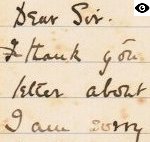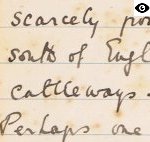
Page 1

Page 2
Letter attached to a copy of Neolithic Dew-ponds and Cattleways - a gift sent to a Philip Hammond from K.P.Hardcastle Xmas 1908
Dear Sir,
I thank you particularly for your kind & very interesting letter about the Camp near Uffington in Berkshire I am sorry to say I do not know that camp, nor the White Horse there, at all. From what you tell me, I think that there can be no doubt about the neolithic origin of the work, though very likely the Romans availed themselves of it subsequently. The really Roman entrenchments are nearly always, as regards the groundplans, a parallelogram. The neolithic works are invariably in curves. The contrast is well seen near Meon Hill in the Cotswolds. The neolithic is in curves on the top of the hill, the Roman work is a parallelogram in the flat country at the base of the Hill etc. etc.
If ever I have the chance, I shall certainly go to the works you describe, & I shall keep your letter by me and write to you again if I do so. But it not possible to see all the works of neolithic man in this country. Indeed to the accustomed eye, it is {2} scarcely possible to get out of sight of them in the south of England, unrecognized wolf platforms, cattleways etc. are everywhere.
Perhaps one ought not to mention the south of England for their presence is world wide, except where the wolf had it all his own way, as in the Great North German plain. As one goes in the train from Calais to Paris, on the other hand, one is practically never out of sight of the work of neolithic man. Perhaps the most striking examples of it that I have seen are in South Eastern Europe. My brother & I are very glad that you found our little book interesting. The subject is certainly most fascinating & mysterious. Renewing my thanks to you for having written. Believe me to be yours faithfully
Arthur John Hubbard.
If you would like to see hitherto unidentified neolithic cities go to the Cotswold Hills, under Bredon Hill for instance the remains of their dwellings are continuous over an area which even now is not less than 3 miles by ¾ miles. In their dwellings there you can find broken up neolithic pottery in profusion, and the antler of the red deer every now & then.
http://www.cantab.net/users/michael.behrend/repubs/hubbard/pages/letter.html